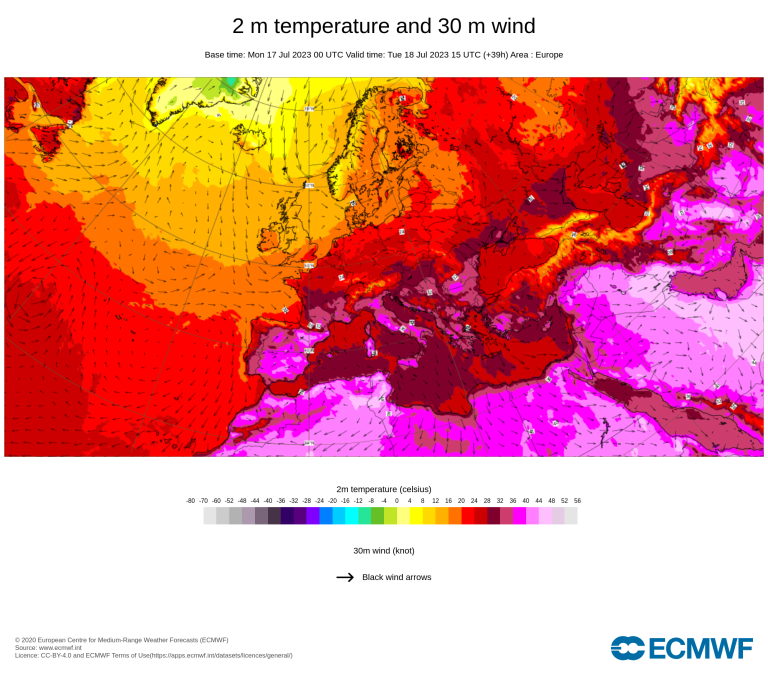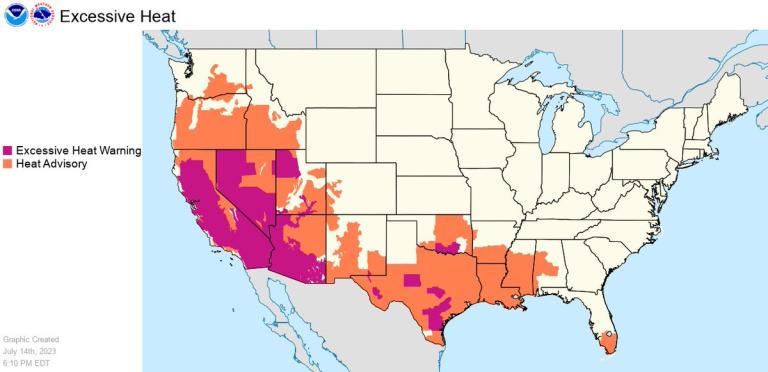Extreme heat, rainfall highlight need for more climate action
Intense heat is gripping large parts of the Northern hemisphere. New daily and station temperature records have been broken and it is possible that some national records may fall. June saw the warmest global average temperature on record, which continued into July, according to preliminary figures.

Meanwhile, heavy precipitation has caused devastating floods and loss of life in some countries, including the Republic of Korea, Japan and northeast USA.
“The extreme weather – an increasingly frequent occurrence in our warming climate – is having a major impact on human health, ecosystems, economies, agriculture, energy and water supplies. This underlines the increasing urgency of cutting greenhouse gas emissions as quickly and as deeply as possible,” said WMO Secretary-General Prof. Petteri Taalas.
“In addition, we have to step up efforts to help society adapt to what is unfortunately becoming the new normal. The WMO community is providing forecasts and warnings to protect lives and livelihoods as we strive to achieve our goal of Early Warnings for All,” said Prof. Taalas.
Heatwaves

Heatwaves are amongst the deadliest natural hazards with thousands of people dying from heat-related causes each year.
The Intergovernmental Panel on Climate Change estimates that by 2050, about half of the European population may face high or very high risk of heat stress in summer.
Much of southern Europe and the Mediterranean is gripped by extreme heat coming from North Africa, increasing health risks, affecting air quality and leading to a high danger of wildfires.
Weekly temperatures up to 5° Celsius above the long-term average in the Mediterranean, according to the Climate Monitoring node of the WMO’s Regional Climate Centre for Europe, operated by the Deutscher Wetterdienst (DWD), the German Weather Service.
Daily maxima will reach frequently above 35–40 °C in many places, in the Middle East and southeastern Türkiye locally up to 45 °C. A further continuation into August is likely. There is an increased risk of heat stress and forest fires, said the Climate Watch Advisory. It is designed as guidance for National Meteorological and Hydrological Services which are responsible for forecasts and warnings in their own territory.
The Spanish meteorological service AEMET warned of temperatures of between 42° Celsius to 44°C and issued top-level red alerts for some interior parts of the country and the Balearic Islands.
Italy’s meteorological service also issued red alerts for extreme heat in southern Italy, Sicily and Sardinia, with temperatures well above 40°C. Parts of the Balkans are also under red alert.
The heat is forecast to intensify by the middle of the week (19 July) in parts of the Mediterranean, including Greece and Turkey.
The EU's Copernicus Emergency Management Service warned of a “very extreme” danger of fires in parts of Spain, in Sardinia and Sicily (Italy) and parts of Greece on 17 July.
Sea surface temperatures (SSTs) of the Mediterranean Sea will be exceptionally high over the coming days and weeks, exceeding 30 °C in some parts, and more than 4 °C above average in a large part of the western Mediterranean.
The impacts of marine heatwaves impacts include migration of species and extinctions, arrival of invasive species with consequences for fisheries and aquaculture.
North Africa is also suffering high temperatures. For instance, the Moroccan meteorological service issued a red alert for extreme heat for southern parts of the country on 13 July, with maximum temperatures of 44 to 49° Celsius.
USA
A widespread heatwave is intensifying in the United States, with high temperatures likely in numerous places, according to the US National Weather Service, which says a few locations could even register their all-time temperature records.
On the weekend of 15-16 July, excessive heat warnings and advisories covered more than 100 million people with “dangerous and swelting heat” especially across much of the Western USA.
Areas at risk in the southwestern USA include California, southern Nevada and Arizona. In South-Central and Southeast USA, maximum heat index values could near or exceed 110 ° Fahrenheit (43° C). Many parts of Florida, including the city of Miami, have been hit by an extended, record-breaking heatwave.
Phoenix, Arizona, has suffered an extended streak of temperatures above 100°F (37.8°C). That will continue, with day time maxiumum temperatures of at least 116°F (46.7°C) until Friday 21 July and overnight low temperatures of more than 90°F (32.2°C), according to the National Weather Service.
A temperature sensor at Furnace Creek in Death Valley National Park in California recorded 128 °C (53.3°C) on 16 July.
According to the Archive of Weather and Climate Extremes, the hottest temperature ever recorded was in Furnace Creek, Death Valley, California at 56.7°C on 10 July 1913.
“Unusually warm waters in the Gulf of Mexico and in the western Atlantic Ocean will contribute to persistent, oppressive humidity in nearly coastal areas and limit nighttime cooling,” said the National Weather Service.
Overnight minimum temperatures are expected to reach new highs, and this will increase the risk of health-related impacts.

In Canada, record-breaking wildfires continue to burn big forest areas. More than 500 wildfires were out of control as of 11 July. According to the Canadian Interagency Forest Fire Centre more than 9 million hectares already burnt in 2023 – compared to the 10-year average of about 800,000 hectares.
Parts of China, including the capital Beijing, have also suffered from an extended heatwave.
“The exceptionally high temperatures in subtropical regions constitute the prime meteorological origin of the extended heat wave over the Mediterranean. The signature of the ongoing El Niño and climate change in the extent of this event, needs more data and analysis ” said Dr Omar Baddour, chief of climate monitoring at WMO.
Heavy rains and floods
Heavy rains and flooding caused severe damage and loss of life in several parts of the world.
Forty people were reported killed as torrential rain and flash floods hit the Republic of Korea on 14 July.
Floods in Northwest China killed a reported 15 people, prompting President Xi Jinping to urge greater efforts to protect the public from extreme weather.
In northern India, roads and bridges collapsed and houses were swept away as rivers overflowed during heavy monsoonal rainfall and flooding which killed dozens of people. The mountainous state of Himachal Pradesh was badly hit, as were the regions of Punjab, Rajastan and Uttar Pradesh. New Delhi reportedly marked its wettest July day in 40 years, with 153 millimeters (6 inches) of rain falling in one day.
The Japanese Meteorological Agency (JMA) issued heavy rain emergency warnings on Monday for the Fukuoka and Oita prefectures, on Kyushu, the country’s third largest island. A new daily rainfall record of 376.0 mm fell on 10 July at Minousan and 361.5 mm at Hikosan, both in the Kyushu region.
In Northeastern USA, parts of New England are facing yet more torrential rainfall on saturated soils following serious floods at the start of July. New York issued a flash flood emergency and more than four million people were under floods alerts on 11 July.
"As the planet warms, the expectation is that we will see more and more intense, more frequent, more severe rainfall events, leading also to more severe flooding,” said Stefan Uhlenbrook, Director of hydrology, water and cryosphere at WMO.
“ Developed countries like Japan are extremely alert, and they’re also very well prepared when it comes to flood management measures. But many low-income countries have no warnings in place, hardly any flood defense structures and no integrated flood management. WMO is committed to improving the situation,” he said.










